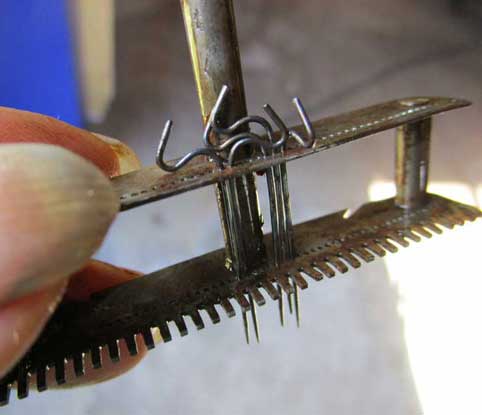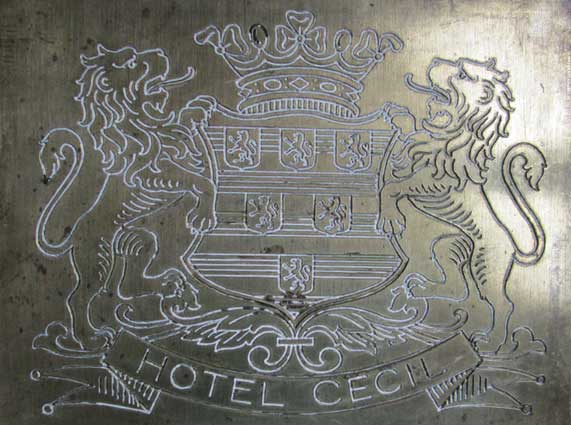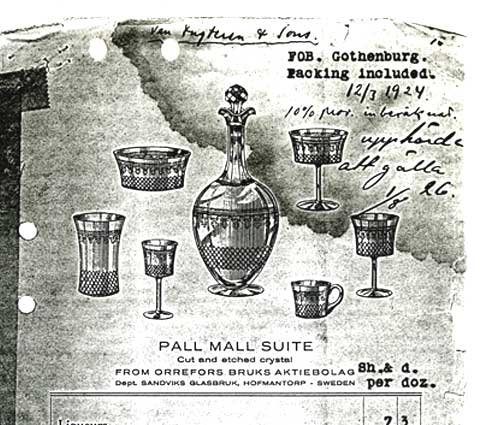|
Attempt at a time line for "etching machines" in Sweden:
|
| |
Occurrence
|
Reference
|
Comment
|
|
1880
|
Reijmyre buys the first "etching apparatus" in Sweden
|
Nisbeth - Fogelberg Reijmyre glasbruk
|
p 51: from J Fougner & Cie in Paris
|
|
Reijmyre buys the first pantograph in Sweden - a 36-piece machine
|
Reijmyre 200 år
|
from France
|
|
Reijmyre buys "Pantograph"
|
Boken om Rejmyre
|
(Pantograf in quotes, and capital P)
|
|
beginning of 1880-ies
|
Eda is offered a patent for glass etching (they do not buy)
|
Fogelberg - Lersjö Eda glasbruk
|
(from a man named Engelbrekt in Stockholm)
|
|
1890-ies
|
Eda uses guilloché machine
|
Eda glasbruk
|
may be a general statement: "In the 1890-ies etching was done with a so called guilloché machine."
|
|
1892 – ca 1920
|
Flerohopp produced lots of glass suites (note: after 1920 they specialized in making bulbs,
the glass pieces of electrical bulbs)
|
Flerohopps glasbruk 1892-1942
|
pantographed from Flerohopp at
Digitalt museum
|
|
1894
|
Kosta buys an "English machine" for etching
|
sign at Ekeberga hembygdsmuseum (local historic museum)
|
compare Steenberg in Modernt svenskt glas
|
|
1896 – 1917
|
the total lifespan of Färe glassworks
(1917 Färe was incorporated in the newly started Elmeverken)
|
pantographed Färe glasses at
Digitalt museum
(may be guilloché, not very good photos)
|
in the glass storage of
Kulturarvscentrum, Växjö there are also guilloché glass from Färe
|
|
1890-ies
|
Kosta produces pantographed restaurant glasses
|
Steenberg in Modernt svenskt glas
|
the book has a photo of glasses for Hotel Cecil, London - BGM has the template. See pictures below.
There are British glass historians who doubt the dating - it ought to be later.
|
|
1897
|
Eda buys a guilloché machine from Pfortzheim
|
Eda glasbruk;
also supported by an inventory list
|
inventory list gives a value: 1 850 SEK
The same list also mentions a "printing press for etching", at a value of 117 SEK.
|
|
1897
|
Kosta buys a guilloché machine from Hamburg
|
Eric Karlsson, binder via B Karlsson, Kosta
|
price 2 000 kr
|
|
1898
|
template for IX Deutsches Turnfest Hamburg 23 - 27 Juli 1898
|
|
BGM has the template - were the glasses produced by Kosta?
|
|
Ca 1900 – 20? 30?
|
Johansfors:
"[production of crystal glass] came to be very big, with decoration, cutting, engraving, taille gravure
and etching"
|
Liv och arbete under 90 år vid Johansfors sid 23
(part of series Glasriket: Människan Miljön Framtiden
|
Nothing more about etching, neither method nor machines
See below 1913
|
|
1902
|
Eda were offered a guilloché machine från Bühler
|
Eda glasbruk
|
star apparatus, three-point "excenterschieber" and adapter for dishes were included (what do these accessories do?)
|
|
1905
|
Kosta buys a guilloché machine from Eda
|
E Karlsson binder via B Karlsson, Kosta
|
price 1 500 kr
|
|
1907
|
Kosta buys a German pantograph
|
sign at Ekeberga hembygdsmuseum;
supported by E Karlsson (no mention of Germany) via B Karlsson
|
|
|
1910
|
Kosta gets yet another German pantograph
|
sign at Ekeberga hembygdsmuseum
|
|
Kosta buys a pantograph with 28 "needle holders" (Germany not mentioned)
|
E Karlsson, binder, via B Karlsson, Kosta
|
price 8 672 kr
|
|
(Kosta sells 2 etching machines to Alsterfors)
|
From Alsterfors at
Digitalt museum - we regard these glasses as guilloché.
This glass looks like
deep etched, which might indicate the existence of a pantograph.
|
|
1910
|
Reijmyre buys a pantograph and two new "etching machines"
|
Reijmyre glasbruk, sid 53
|
|
|
1911
|
(Kosta: in the books there are clichés and pantograph templates worth 5 000 kr)
|
E Karlsson, binder, via B Karlsson, Kosta
|
|
|
1912
|
Sandvik: Oscar Franzén began working there
|
Glas, kultur, sammhällsdaning
|
p 30: "There was much etching done, and the acid used was emptied outside the door."
|
|
1913
|
Sandvik "before the war [...] various plain, cut and etched glass in semi-crystal. As the etching
was not profitable, [Edvard Strömberg] decided to abandon etching during the autumn of 1913."
|
Fogelberg: Glasteknisk tidskrift 1990:3
|
compare below 1919, 1921
One guilloché example found at Digitalt museum.
The production year is given as 1910 |
|
1914
|
Pukeberg shows "wine glasses […] guilloché technique" at "The Baltic exhibition",
Malmö
|
Krantz, Den småländska glasregionens uppgång och fall: en ekonomisk historia, p 98
|
compare our renovation of a
"panto-graving machine" which was said to come from Pukeberg. Beside the machine was mounted a page from the
1910 catalogue from the Kutzscher company. (That machine doesn't have any maker's sign)
|
|
1914
|
Orrefors owned 2 etching machines which were used "for a couple of years"
(a few pages later Hellner mentions "engraving and etching" during 1916)
|
Kärlek till glas
|
p 38:
Eugen Bergqvist (nephew of Knut) operated them, was also responsible for transfer etching.
After they were "put aside […] etching has not been used as a means of decoration at Orrefors since then"
(Orreforsaren i Glasriket mentions an etcher called Heinrich Wollman,
working at O during 1914-23)
|
|
1917
|
Elme glassworks is started, makes Färe a subsidiary.
At the end of the 20ies Ollers gets to Elme
|
Elme : glimtar från utställningen om Elme glasbruk på kulturhuset Blohmé i april 1997
|
Notes found at
Digitalt museum (no pictures 180426)
In the storage there are also guilloché glasses
|
|
1917
|
Kosta buys an etching machine from Reijmyre
|
E Karlsson, binder, via B Karlsson, Kosta
|
|
|
1919
|
Sandvik produces Pall Mall
|
Glas, kultur, samhällsdaning, p 43
|
(compare above 1913, below 1921)
|
|
1919
|
Reijmyre has 6 "gilloscheringsmaskiner", nothing said about pantograph
|
Anteckningar från ... Reijmyre..
|
Kaijser doesn't mention pantographs – as seen above Reijmyre should have two (1880 & 1910)
|
|
1920-ies
|
Åfors have "etchers doing both transfer and machine etching"
|
I skenet från en glasugn
|
Åfors had a "panto-graving machine" and a pantograph (later donated to
Kulturarvscentrum)
|
|
1921
|
Orrefors "dept Sandvik"
Price list for table-glass of soda quality
"etched keys and border" (meander pattern) on 5 sizes of stemware;
"etched circles" on 5 sizes of stemware
|
Blue binder at the association Glas i Hovmantorp, photocopy of a price list printed 1921
|
(compare above 1913, 1919)
(Sandvik became part of Orrefors in 1917, was bought in 1918)
|
|
1924
|
Orrefors "avd Sandvik"
Copy of a price list for Pall Mall (in English), dated 12/3 1924 (date handwritten)
(note by another hand: expired 1/8 26.)
|
Blue binder at GiH, photocopy of a typewritten price list
|
|
|
1926
|
Reijmyre is closed down:
|
|
|
|
|
9 June
|
the hot shop is closed
|
the timetable comes from the foreword to Anteckningar från ... Reijmyre.., written by Fogelberg
|
|
15 July
|
the heating, cracking-off and edge-melting workshops close
|
|
24 July
|
the crystal cutting shop closes
|
|
31 July
|
the pantograph workshop is closed
|
|
18 August
|
the etching workshop is closed
|
|
October
|
the stamping and egngraving shops close
|
|
"after that"
|
only the service Pall Mall is "processed", with blanks blown at Eda
|
as Pall Mall is both cut and etched - HOW?
|
|
1926
|
Eda gets a pantograph and etching machines from Reijmyre (also the making of Pall Mall)
|
Lersjö: Glas från Eda
|
Despite the non-mention of pantograph(s) by Kaijser, at least there was one.
Maybe the Venon suggestion (below) indicates the existence of two.
|
|
1926
|
Pukeberg buys a German pantograph for 12 glasses
|
Pukebergs glasbruk 75 år
|
|
|
(Mr Venon suggests that Pukeberg buy the Reijmyre pantograph)
|
(Venon was the agent for several Swedish glassworks, for the USA market)
|
1927
|
Alsterbro buys an "automatic etching machine"
|
Scheutz - Fogelberg: Alsterbro glasbruk
|
("[…] the manager wished to buy […] automatic etching machine […]
The proposal was approved by the board of Kristallbolaget.") (my translation)
|
|
1928
|
Ekenäs made etched vases for king Gustaf V:s 70th birthday
|
Ekenäs: vi som försvann... sid 35
|
|
|
around 1930
|
Alsterfors take on etchers from Eda and Reijmyre
|
Ett glasrike i Glasriket: Älghults socken sid 31
|
(nothing mentioned about machines)
|
|
1930
|
Eda takes part in the Stockholm exhibition, showing service "Bero"
|
Glas från Eda
|
BGM has the template (see pictures here)
|
|
later
|
Kosta sells the same service "Bero"
|
several Kosta catlogues from the 1930ies and 40ies
|
|
1937
|
Trelleborgs glasindustri: Knut Harald Heintze (from Kosta) is employed as an etcher
|
Fogelberg-Scheutz: Trelleborgs glasindustri 1919-1955
|
On p 39 it is mentioned that a pantograph existed at the benkrupcy; on p 88 it is told that "big vases […]
a machine drew the patterns."
|
|
"during the war"
|
Ekenäs etches, both deep etching and matt etching
|
Ekenäs: vi som försvann...
At a visit in Oct '17 we were told that there was never a pantograph
|
"[…] I still own old steel templates […export…]
all over the world […]"
(nothing mentioned about machines)
|
|
1946
|
Skruv burned down
|
Ljuders hembygdsbok 2007
|
The etching shop, housed in a wooden building east of the hot shop, did not burn.
|
|
1947
|
Boda: Erik Rosén is hired
(legendary glass-man to be)
|
Generationers arbete på Boda Glasbruk
|
"Post-production was advanced here: we had a big cutting shop, engravers, etching shop and painting shop."
According to The Glass Factory, the only etching done in Boda was transfer etching.
|
|
1958
|
Pukeberg participated in the exhibition "Tre glasbruk" (Three glassworks)
|
Göran Wärff's series "Himmel och helvete" (Heaven and hell) at
Digitalt museum
|
these may be the last newly designed pantographed glasses in Sweden?
|
|
1961
|
newspaper clipping with photo from Målerås: "Henning Ohlsson at work with the pantograph"
|
(Smålandsposten or Barometern)
|
According to Mats Jonasson, that pantograph was later melted down and made into blow-moulds.
(MJ took over after Kosta in 1981 - did it happen after that?)
|
|
after 1965
|
"Flygsforsgruppen", consisting of Flygsfors, Målerås and Gadderås,
in existence 1965-1974
|
Folke Walwing makes guilloché grog glasses, at
Digitalt museum
|
the glasses can have been produced at any of the places
|
|
1970?
|
Smålands museum is gifted a pantograph from Åfors (a 24-piece, similar, but not quite the same, as ours)
|
Can be found at Digitalt museum
|
according to that entry it did not enter the museum until 1995 - that does not match other information we have been given
|
|
1974
|
reportage on pantographing at Kosta
|
company internal magazine Mängen 1974:2; read it
here.
|
note: this reportage is about the horizontal pantograph we have here at BGM
|
|
1980-ies, before 1985
|
Kosta ends their pantographing
|
|
the latest glasses were "St Erik" for Stockholm City (see picture below)
|
|
?
|
Skruf had guilloché machine(s?), but when?
|
Told by Hasse Karlsson
|
(who also told that, at least once, hydrofluoric acid was dumped in an open ditch)
|
|
2015
|
|
(BGM has a template marked JOHAN FRÖBERG FINSPONG - can that one be from Reijmyre?)
|
(The firm, now called Fröbergs stämplar, still exists in Finspång. They do not recognize making templates for
Reijmyre)
|
|
2015
|
|
(BGM has two handwritten pattern books, undated, one written by Einar Petersson.
The other one is often mentioning the "aqvarellapparaten" when showing guilloché patterns)
|
(It has been confirmed that Einar Petersson was an etcher at Kosta from 1930ies on)
|
|
2015
|
|
Personal communication: a similar pattern book from Orrefors was given to Smålands museum during ... 1980-ies?
|
(see above 1914. Sandvik became part of Orrefors 1917, so they can be from there)
|
|
2015
|
BGM is given a horizontal pantograph for 24 glasses
|
|
donation from AB Kosta glasbruk
|
|
2017
|
BGM gets a vertical pantograph for 12 glasses
|
|
The machines were found in the old storehouse called "Långholmen" in Kosta.
They were donated to BGM from AB Kosta glasbruk.
We have heard that several belongings of Svenska Kristallglasbruken were stored here - which might mean that our machines
could have been used at several glassworks
|
|
BGM gets a Kutzscher guilloché machine, model Jupiter (for one glass)
|
(all cogwheels in multiples of 5 and 0)
|
|
BGM gets an anonymous guilloché machine for one glass
|
(with this machine the cogwheels have different multiples, compatible with the recipes in the pattern books mentioned above,
such as Joel, Lina)
|
" Glasen [...] bäras till etsnings maskinen.
".
Vid Reijmyre finnes 6 st. dylika. De är försedda med en inre rörlig del, i hvilket glaset ställes och där det
.
handtag eller vef rörlig i vissa riktningar upp och ned
samt i sidled) så att olika mönster kan åstadkommas. Själfa etsningen, som består i att vaxet rispas bort från glaset,
sker genom olika antal nålar allt efter olika mönster. Vid Reijmyre användes vanliga synålar, krökta och fastsatta med
gummisnoddar. Eljes kan man ock köpa särskildt härför afsedda nålar, men de blifva dels dyrare dels hålla de ej så länge,
emedan de äro af lösare material (köpas utomlands). Det munstycke, i hvilket nålarne äro fästade, kallas vanligen kamm.
"





